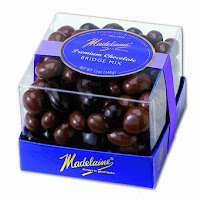I've always had a sweet tooth. When I was a kid, candy was an important source of energy. Getting my hands on it was initially a bit tough; between my lack of funds and the fact that candy retailers lay on the far side of streets I wasn't permitted to cross, I had to rely on what mom brought into the house. Lucky for me, my mom has a thing for chocolate...
From a young age, I remember Sixlets . If you’re not familiar, they're small candy coated chocolate spheres usually sold in cellophane wrappers. They sit expectantly in a single file line, perfect for tipping back the whole thing into your mouth at once as you would with a bag of M&M's. Or at least I would. Or have. Hell, hundreds of them. Anyway... Sixlets are like spherical M&M's, or so I thought until I received an education in chocolate...
. If you’re not familiar, they're small candy coated chocolate spheres usually sold in cellophane wrappers. They sit expectantly in a single file line, perfect for tipping back the whole thing into your mouth at once as you would with a bag of M&M's. Or at least I would. Or have. Hell, hundreds of them. Anyway... Sixlets are like spherical M&M's, or so I thought until I received an education in chocolate...
Why is chocolate italicized in reference to Sixlets? Because it's not chocolate, per se. It's compound chocolate, as opposed to milk chocolate, or dark chocolate, or even white chocolate, which isn't actually chocolate either... You see, I've worked for a few food and pharmaceutical companies in the “know everything about our product” department. Shedding ever shifting titles, I'm usually the guy people go to when they want correct answers. Working in that capacity for a candy company required countless hours of product research; some of that time was simply spent savoring chocolate. I'll tell you what I know.
Chocolate is similar to coffee, derived from a plant via it's seeds or beans, respectively. Roasted and ground, the cocoa beans give up two things; cocoa solids (the essence) and cocoa butter (fat). It's the proportions of these two components, with the addition of other players (milk solids, sweeteners) that yield what we know as real (milk, dark, etc.) chocolate. White chocolate is made without the cocoa solids, just a mixture off sugar, milk, and cocoa butter. Compound chocolate is, in short, like mixing hot cocoa mix and water with waxy fat. Yum. Sixlets (made in Canada) at least use decent fat; palm kernel oil. Lesser quality compound chocolate (China and elsewhere) well, we wont talk about that. Clearly chocolate is a worldwide commodity, and some countries do it better than others. Here's a quick rundown of the noteworthy. (my blog, my palate, my rules...)
Belgian chocolate is the best in the world. They take it very seriously, and it's reflected in the quality and price. The silky mouthfeel and delicate flavor is lost on some people; they like a Hershey bar as much as anything. The difference? Put a Hershey's kiss on top of a sugar cookie and bake it. When it cools, it looks like it did when you started. Now take a piece of Belgian chocolate and set it on the counter in the sun. Within minutes, it will liquify and run off the counter. That's the kicker; Belgian chocolate can be so delicate that it's hard to get good product here in the States. Shipping conditions will make or break it. (a sideways glance cast at you too, Heineken)
Swiss milk chocolate is a very close second to Belgian. The good people at Chocolat Frey AG, based in northern Switzerland, produce and export hundreds of chocolate products, both seasonal and year-round. The finest cookies I ever made started from my modified Tollhouse recipe with Frey milk chocolate chunks and english toffee pieces. On top of producing excellent chocolate, Frey is a globally responsible company; they are ISO-certified as environmentally friendly and support orphans in Africa.
How about American made chocolate? It doesn't get more American than Madelaine's Chocolate, made in the city, county, and state of New York. I think they produce some of the finest panned candy available. What's “panned” mean? Think chocolate covered anything! Almonds, coffee beans, malt balls, cherries... They also do great molded and foil wrapped chocolates.
I'll offer an honorable mention here to the Ghirardelli Chocolate Company. An American company, started by an Italian, and currently owned by the Swiss, thanks to effective marketing Ghirardelli is what most Americans think of as good chocolate. It's pretty good; certainly better than anything from the big American companies, but not as refined as it's European brethren.
In closing, get out there and try something different. Spend a few bucks on a chocolate bar with foreign printing on it. Develop your palate for chocolate the same as you would with wine and other foods.
Knowledge is power, and in this case it's pleasant research!
Knowledge is power, and in this case it's pleasant research!







Lindor chocolate balls........yummmmmmmmmm
ReplyDeleteOkay, you know a little too much about chocolate, but "knowledge is power" - love it!
ReplyDeleteI think I'll take your suggestion to heart and do some research. There are several local companies here that make their own (sort of like microbreweries) so maybe that's a place to start.
ReplyDelete